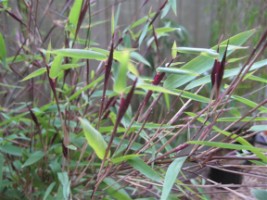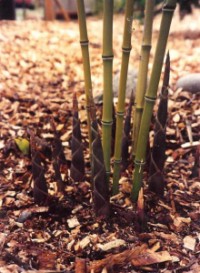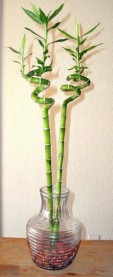There are two general growth patterns of bamboo, "clumping" (sympodial) and "running" (monopodial). Clumping bamboo species tend to spread slowly, typically spreading two to five inches outward each summer. "Running" bamboos spread much faster, requiring a barrier for containing both roots and underground stems, called rhizomes.
Bamboos flower every twenty to one hundred years. Once full bloom takes place a plant will flower from one to eight years then die entirely. Some bamboos for example Ph. edulis 'Moso' only flower sporadically. Here only one branch or one culm in your grove will be effected. When this happens the bamboo plant will not die. Photo to left is Fargesia nitida in full bloom.
Depending on variety of bamboo, new shoots usually emerge late March through June. They top out within 4 to 6 weeks for that summer and never grow taller. Next years new shoots will come up fatter and taller then previous year. We've seen double the number of shoots come up each year at our nursery. Photo on left shows Ph. atrovaginata putting up larger new shoots than previous year.
Bamboo growth can be controlled by surrounding the plant or grove with a concrete wall or using (24 to 30 inch deep) 40 mil. thick HDPE plastic root barrier.
Bamboo mites "Schizotetranychus celarius" are indigenous only to bamboo. They leave yellow splotches that make bamboo leaves look unhealthy. If you look underneath the bamboo leaf and find white webbing, bamboo mites may be present. Photo on right shows bamboo mite webbing on back side of leaf with yellow splotching on top side.
The ornamental plant sold in containers and marketed as "lucky bamboo" is actually an entirely unrelated plant, Dracaena sanderiana. It is a resilient member of the lily family that grows in the dark, tropical rainforests of Southeast Asia and Africa. Lucky Bamboo is sometimes mistaken for real bamboo. On a similar note, Polygonum cuspidatum or Japanese knotweed, also known as summer bamboo, is not bamboo either.

(c) 206-920-6613 |
Open 7-Days A Week by Appt. Call Before You Arrive. |







